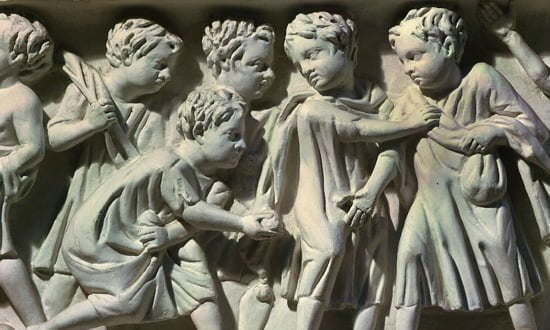
From the very beginning, the church has always sought to put 1 John 3:18 into action, “My little children, let us not love in word, neither in tongue; but in deed and in truth.” Here is an enlightening quote from the Encyclopedia of Ancient Christianity,
“The life and circumstances of children depended on their parents and masters; no law explicitly defended them. Christianity sought through its moral influence to eliminate inhuman practices against children, radically defending human life both before and after birth (Didache 2,2; Ps.-Barn. 19,5; Apos. Con. VII, 3,2; Athen., Leg. 35,6; Tertull., Ap. 9,6-8); it raised its voice against the cruelty of parents or masters (Eph 6:4), helping out where possible. Christians opposed the practice, widespread in antiquity, of exposing children: if one did not want to raise a newborn, the child was exposed in a particular spot in the city, at Rome on the banks of the Tiber or near the Columna Lactaria in the Forum Holitorium, where anyone could pick him up and use him for their own interests, either educating or selling him as a slave. In ancient Christian literature, *Hermas wrote that this had happened to him (Vis. I,1,1).
Christians took in these exposed children to save them, though often they could do nothing more than bury them, as the tombs of many children and inscriptions in the catacombs attest (Diehl II,142-143); in some cases consecrated virgins (Aug., Ep. 98) or benevolent wealthy families educated them. They were called alumnus, proiectus, stercorius, kopron, threptos. After Constantine, laws began to protect these abandoned children, defending them as free persons (CJ VIII, 52,3-4). Later it was largely *monasteries that assumed the burden of educating these children, establishing conditions for their admission to a convent; orphans were accepted unconditionally (Basil, Reg. Maior, 15).
In the oblatio, which appeared in the 4th c., for a variety of reasons—poverty, religious motives, difficult situations—parents offered their children to God’s service, the biblical precedent being the story of the young Samuel (1 Sam 1:1–3:21). At the beginning of the Middle Ages the most common way of educating exposed or abandoned children was begun: in 787 Dateus, archpresbyter of *Milan, donated a house near the church of S. Salvatore to protect them: the first brephotrophium.“
-Berardino, Di Angelo. “Child.” Encyclopedia of Ancient Christianity, IVP Academic, Downers Grove, IL, 2014, pp. 536–538.
Recently, I had the privilege of adopting one such child. I am honored to be a member of a church where adoption and fostering is a welcome and widespread practice. Here is a devotional I gave on the day we celebrated the adoption of our daughter:
Here is the file in case the YouTube link does not work:
Thankfully, the church has not stopped, and will not stop defending life, and giving a family name to those without one. This is the best analogy for the gospel that we have in our earthly experience. This is one of the ways the victory of Christ over death, sin and the world manifests itself.
“The light shines in the darkness, and the darkness has not overcome it.” – John 1:5
~Christus Victor~

